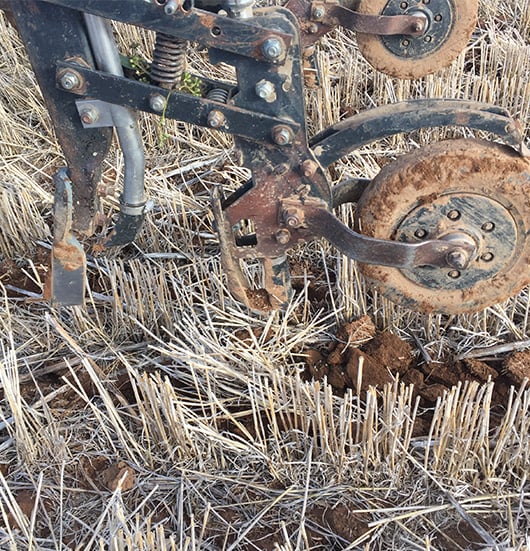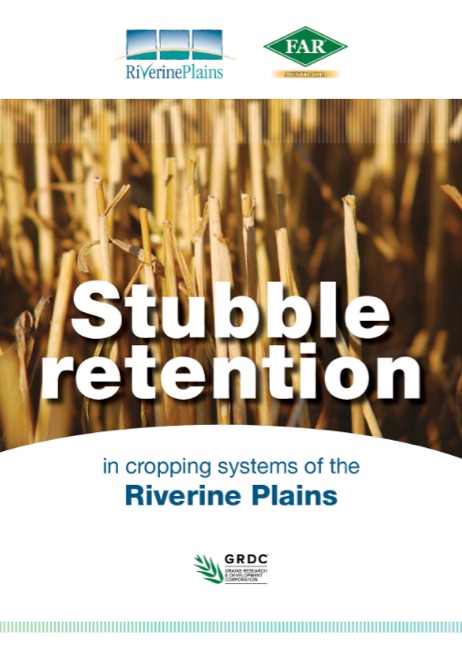Stubble retention in cropping systems of the Riverine Plains
Learnings from local research evaluating the impact of different stubble management techniques and agronomic practices on yield and quality.

Publication date
01 Jun 2019
Publication partner
This publication was supported by the Grains Research and Development Corporation.
LEARN ABOUT OUR RESEARCH INTO NO-TILL STUBBLE RETAINED SYSTEMS IN THE RIVERINE PLAINS
This publication provides a comprehensive summary of the outcomes and learnings from the Riverine Plains and GRDC Stubble Project, which ran from 2013 – 2018.
The project involved both large field trials (large-plot trials) and small-plot research at sites across the Riverine Plains from 2013–17, with each trial addressing a specific aspect of stubble management in a no-till stubble retained (NTSR) system.
The large-plot trials were designed to test the long-term impact of a one-off change in management, with trials established at different sites every year at a scale that reflected paddock practice.
The small-plot field trials addressed a range of distinct issues related to the agronomic management of crops grown under NTSR systems. These included:
- Monitoring the performance of nitrogen application to wheat under full stubble retention
- Early sowing and the interaction with row spacing,plant populations and cultivar in first wheat under
full stubble retention - The interaction between plant growth regulator (PGR) and nitrogen application in early-sown first wheat
- The interaction between fungicide application and in-crop nitrogen timing to control yellow leaf spot (YLS) in early-sown wheat
- A stubble height trial, which investigated the interaction between stubble height, light interception and biomass lag at three stubble heights (in-canopy temperatures were also measured).
What we discovered
Key learnings and messages from the Stubble project were that:
- Stubble management is not a key driver of yield. As such, it's recommended farmers retain stubble where possible, but use other tools, such as straw removal, mulching or incorporation, to manage stubble to optimise the efficiency of the farming system and machinery. Try to use burning as a strategic tool only when necessary.
- Row spacing (22.5cm or 30cm) is less important in determining wheat yield in early-sown (mid-April) crops compared with later-sown crops (late May – early June).
- During the four years of trials, applying a plant growth regulator did not deliver any positive yield effects or consistent quality effects.
- Applying nitrogen increased yield potential, however the timing of the nitrogen application (split, single dose etc) did not influence yield. Given there is no penalty for applying nitrogen in a split application, a high rate of nitrogen up front, or early, could be valuable under wetter conditions, while a lower rate of early nitrogen could reduce upfront costs when dry sowing, or where the break is late.
- Applying either Prosaro (tebuconazole/prothioconazole) or Tilt (propiconazole) typically provided yellow leaf spot (YLS) control in the range 25–50%, which led to small, but consistent, positive yield effects. It's recommended that farmers use fungicides to control YLS during a wet spring, however sowing resistant varieties and employing rotations that include break crops, such as canola and pulses, also can help control YLS.
- Long stubble shades the emerging crop, resulting in a delay in flowering and maturity. Farmers can use this to their advantage by sowing crops earlier into long stubble and having them still flower in the right window, thus spreading the sowing window. If using two headers in a paddock, changing stubble height between headers will spread the flowering window of the following crop within the paddock over several days. This will reduce the risk of economic frost damage across a whole paddock/variety.
- Long stubble does not significantly increase the risk of frost in the Riverine Plains region. While in-canopy temperatures differences were measured across the Stubble project trials, these were not physiologically significant. Rather, the difference in flowering date due to shading in high stubble meant either the burnt or retained treatments had more frost damage during 2017, depending on which treatment was flowering at the time of the frost event.
- 8. Soil sampling should be conducted at repeatable GPS referenced locations across different soil types. Farmers should avoid the bulking together of soil samples that commonly occurs with transect sampling and instead adopt incremental sampling. This will provide a greater opportunity to detect changes in soil properties over time.
- Variable rate nitrogen management is of highest value in seasons where water is limiting and when there are strong changes in clay content/CEC across a paddock. Zones developed through EM surveys need to be ground-truthed in order to determine which soil properties are likely to drive or limit production in each zone.
Summary: Comparable yields can be achieved in stubble retained and burnt systems. Even if full stubble retention is not feasible due to machinery, weeds or disease constraints, there are other options such as shallow incorporation, cutting short or straw removal which can provide flexibility, reduce the frequency of burning and address timeliness related issues.
Learn more about the local trials, results and learnings from the Stubble project.
NEWS
Discover unique perspectives on agriculture from across the Riverine Plains.
-
Livestock
-
People
-
Grains
-
Sustainability

